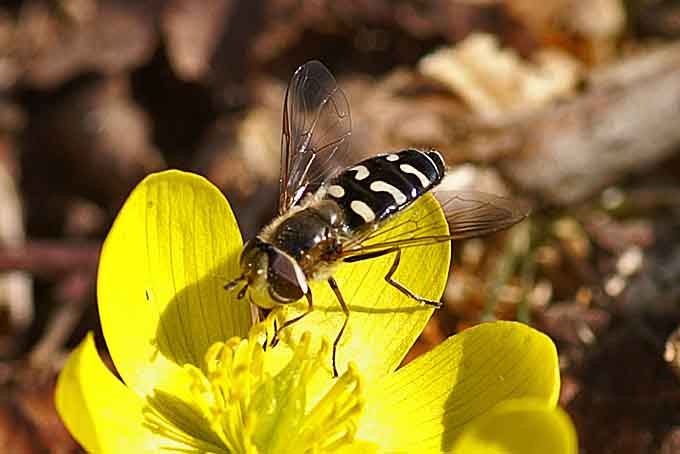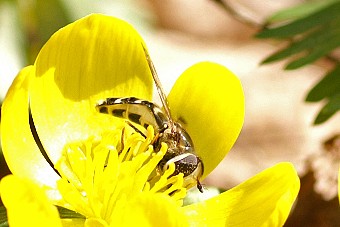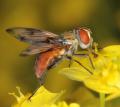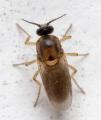Diptera.info :: Family forums :: Syrphidae
|
First Syrphids around in Ostwestfalen/Germany :-)
|
|
| Juergen Peters |
Posted on 23-03-2006 21:38
|
|
Member Location: northwest Germany Posts: 14214 Joined: 11.09.04 |
Hello! Three days ago I watched the first Eristalis here but wasn't able to take a picture, today I managed it :-) - although from quite a distance.  On the snowdrops at the wood's edge were feeding some honey bees and also several Episyrphus balteatus:  I also found a third Syrphid species, but it flew off just when I wanted to actuate the trigger of my camera :-(. It was black with comma shaped markings on its abdomen. I think it must have been Melangyna quadrimaculata. For the butterfly friends: also for the first time in 2006 the Small Tortoiseshells (Aglais urticae) were flying (26 (!) individuals on less than 300 m meadow): http://insektenin...icae_1.jpg Best regards, Jürgen -=-=-=-=-=-=-=-=-=-=-=-=-=-=-=-= Juergen Peters Borgholzhausen, Germany WWW: http://insektenfo... -=-=-=-=-=-=-=-=-=-=-=-=-=-=-=-= |
| Zeegers |
Posted on 24-03-2006 17:26
|
|
Member Location: Soest, NL Posts: 19086 Joined: 21.07.04 |
Hi Juergen Your comma-syrphid is most likely Scaeva selenitica. As the other two species, adults may hibernate. Melangyna quadrimaculata definitely does not match your description (markings quite rectangular in that species). Theo Zeegers |
|
|
|
| dipdip |
Posted on 24-03-2006 20:08
|
|
Member Location: Thunersee Switzerland Posts: 360 Joined: 17.12.05 |
Hello! Why do you think it is S. selenitica? Here in Berner Oberland the first syrphid I found was S. pyrastri, here on Erantis on 19.03.2006. From that day on I saw them every day, but only females. Seems the boys still sleep. Nice day! Maja dipdip attached the following image:  [58.67Kb] |
|
|
|
| Juergen Peters |
Posted on 24-03-2006 20:58
|
|
Member Location: northwest Germany Posts: 14214 Joined: 11.09.04 |
Hello, Theo! Zeegers wrote: Your comma-syrphid is most likely Scaeva selenitica. As the other two species, adults may hibernate. Melangyna quadrimaculata definitely does not match your description (markings quite rectangular in that species). Unfortunately I could only catch a short glimpse at it before it flew away, but it was definitely no Scaeva. I know only the abundant Scaeva pyrastri from here, which is much larger! And I never found it before May. That fly yesterday was for sure a species, which I never saw before and which is not featured in my books, so I looked at www.syrphidae.com. The first species that resembled mine there was Anasimyia transfuga with its tiny comma shaped spots (smaller than those of Scaeva). But I do not know anything about that species and whether it flies so early in the year and appears here in Ostwestfalen. So I moved to the next resembling ones, which were Melangyna quadrimaculata and M. umbellatarum, which are very early flying species. The spots of M. umbellatarum were too big, and additionally the general body shape and habit impression of the fly on the M. quadrimaculatum-pic on http://www.syrphi...ent=Europe were striking. Meanwhile I saw other photos of M. quadrimaculata with orange-yellow markings (pics by Gerard Pennards), which let me question my first opinion. The three or four pairs of small spots on the otherwise shining black body of "my" fly were pure white. I am even not sure if it was a Syrphid, but I don't find other flies resembling it... Best regards, Jürgen -=-=-=-=-=-=-=-=-=-=-=-=-=-=-=-= Juergen Peters Borgholzhausen, Germany WWW: http://insektenfo... -=-=-=-=-=-=-=-=-=-=-=-=-=-=-=-= |
| Zeegers |
Posted on 25-03-2006 11:20
|
|
Member Location: Soest, NL Posts: 19086 Joined: 21.07.04 |
Oke, let's slow down. First of all, M. umbellatarum is not an early spring species. Secondly, M. quadrimacualata does not have comma-shaped markings, so your description does not fit. Thirdly, hibernation of Scaeva pyrastri is quite unusual, whereas it is common in Sc. selenitica. At least in The Netherlands. Fourthly, I'm not sure about the picture. It is a Scaeva no doubt, but given the point of view I cannot be sure about the species. It could be Sc. pyrastri. Still, seeing many pyrastri and no selenitica at all on a day in March does seem quite unlikely to me. So, be sure to check ! Theo |
|
|
|
| dipdip |
Posted on 25-03-2006 20:26
|
|
Member Location: Thunersee Switzerland Posts: 360 Joined: 17.12.05 |
So Scaeva questions don't help J?rgen, I see. May be you allow me anyway to ask another - I saw white markings - I see in the picture bowed markings that come nearer to the beginning of the segment in the middle than on the side. - I don't see black rings on tibias But I must say that I never catched a real ventral view. Would that be a definite prove? Thank you for helping Maja dipdip attached the following image:  [24.49Kb] |
|
|
|
| Juergen Peters |
Posted on 25-03-2006 21:38
|
|
Member Location: northwest Germany Posts: 14214 Joined: 11.09.04 |
Hello, Theo and Maja! Zeegers wrote: First of all, M. umbellatarum is not an early spring species. Secondly, M. quadrimacualata does not have comma-shaped markings, so your description does not fit. Thirdly, hibernation of Scaeva pyrastri is quite unusual, whereas it is common in Sc. selenitica. At least in The Netherlands. I think without a photo the identification of my early Syrphid will lead to no result and remain speculation. The only thing I know for sure, is that it was no Scaeva. This genus was one of the most abundant here last summer, and I know it quite well and took many photos: ,%20Maennchen_001.jpg) http://insektenfo...en_010.jpg http://insektenfo...en_011.jpg http://insektenfo...en_001.jpg http://insektenfo...en_005.jpg http://insektenfo...en_007.jpg I think those flies are all S. pyrastri, I never watched an undoubted S. selenitica here and never a Scaeva before May. Most of the photos above were taken from July to early September. Best regards, Jürgen -=-=-=-=-=-=-=-=-=-=-=-=-=-=-=-= Juergen Peters Borgholzhausen, Germany WWW: http://insektenfo... -=-=-=-=-=-=-=-=-=-=-=-=-=-=-=-= |
| Jump to Forum: |













